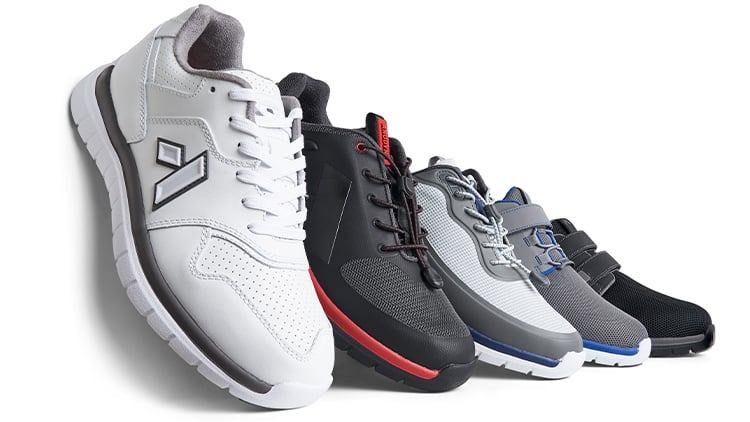For individuals with diabetes, proper foot care is paramount. Diabetic shoes play a crucial role in maintaining foot health, as they are specially designed to provide support, alleviate pressure points, and reduce the risk of complications such as ulcers and infections. However, keeping these shoes clean and odor-free is essential to ensure their effectiveness and prolong their lifespan. In this comprehensive guide, we'll explore some tips and best practices for maintaining optimal hygiene in diabetic footwear. 
Understanding the Importance of Footwear Hygiene for Diabetics
Before delving into the specifics of cleaning and deodorizing diabetic shoes, it's essential to understand why proper hygiene is particularly crucial for individuals with diabetes.
- Reducing the Risk of Infections: People with diabetes are more susceptible to foot infections due to poor circulation and nerve damage. Bacteria and fungi thrive in warm, moist environments, making sweaty or dirty shoes a breeding ground for potential infections.
- Preventing Foot Odor: Diabetic neuropathy can impair sweat gland function, leading to excessively dry or sweaty feet. This imbalance creates an environment where bacteria can proliferate, resulting in unpleasant foot odor.
- Preserving Foot Health: Ill-fitting or unclean shoes can cause friction, blisters, and pressure points, which may lead to foot ulcers and other complications. Maintaining proper footwear hygiene is essential for preventing these issues and promoting overall foot health.
Tips for Cleaning Diabetic Shoes
- Check Manufacturer Guidelines: Before cleaning diabetic shoes, refer to the manufacturer's guidelines for specific care instructions. Different materials may require different cleaning methods, and following the manufacturer's recommendations will help avoid damage. Review the Anodyne Shoes Break In and Product Care instructions carefully to get the most out of your shoes.
- Use Mild Detergent: When washing diabetic shoes, opt for a mild detergent or soap solution and lukewarm water. Harsh chemicals or abrasive cleaners can degrade the materials and irritate sensitive skin.
- Hand Wash Whenever Possible: Unless otherwise stated by the manufacturer, it's generally best to hand wash diabetic shoes rather than machine wash them. Gently scrub the exterior and interior with a soft brush or cloth to remove dirt and debris.
- Air Dry Thoroughly: After cleaning, allow the shoes to air dry completely in a well-ventilated area. Avoid using direct heat sources such as hair dryers or radiators, as excessive heat can warp or shrink the materials.
- Replace Insoles Regularly: Diabetic shoe insoles can harbor bacteria and absorb sweat, leading to odor and potential infection. Replace the insoles regularly, following the manufacturer's recommendations, to maintain hygiene and comfort.
Deodorizing Diabetic Shoes
In addition to regular cleaning, deodorizing diabetic shoes is essential for combating odor-causing bacteria and keeping feet fresh. Here are some effective methods for deodorizing diabetic footwear:
- Sprinkle Baking Soda: Baking soda is a natural deodorizer that can help neutralize odor in diabetic shoes. Sprinkle a small amount of baking soda inside the shoes and let it sit overnight before shaking or brushing it out the next day.
- Use Odor-Eliminating Sprays: There are many over-the-counter sprays specifically formulated to eliminate shoe odor. Look for products containing natural ingredients, such as our No. 122 Antimicrobial Protectant.
- Air Out Shoes Regularly: Allow diabetic shoes to air out between wears to help reduce moisture buildup and prevent odor. Remove the insoles and loosen the laces to promote airflow and speed up the drying process.
- Rotate Shoes: Rotating between multiple pairs of diabetic shoes allows each pair to air out thoroughly between wears. This helps prevent moisture buildup and reduces the risk of odor and bacterial growth.
- Consider Shoe Inserts: In addition to diabetic insoles, consider using odor-absorbing shoe inserts or sachets containing activated charcoal or silica gel. These can help absorb moisture and keep shoes smelling fresh.
Maintaining proper hygiene in diabetic shoes is essential for preventing infections, minimizing foot odor, and preserving foot health. By following these tips for cleaning and deodorizing diabetic footwear, individuals with diabetes can ensure their shoes remain clean, comfortable, and effective in supporting overall foot health. Remember to consult with a healthcare professional for personalized foot care advice and recommendations. With consistent care and attention, diabetic shoes can continue to provide the support and protection necessary for a healthy and active lifestyle.


.png?width=116&name=Anodyne_circle_1_logo%20(2).png)
